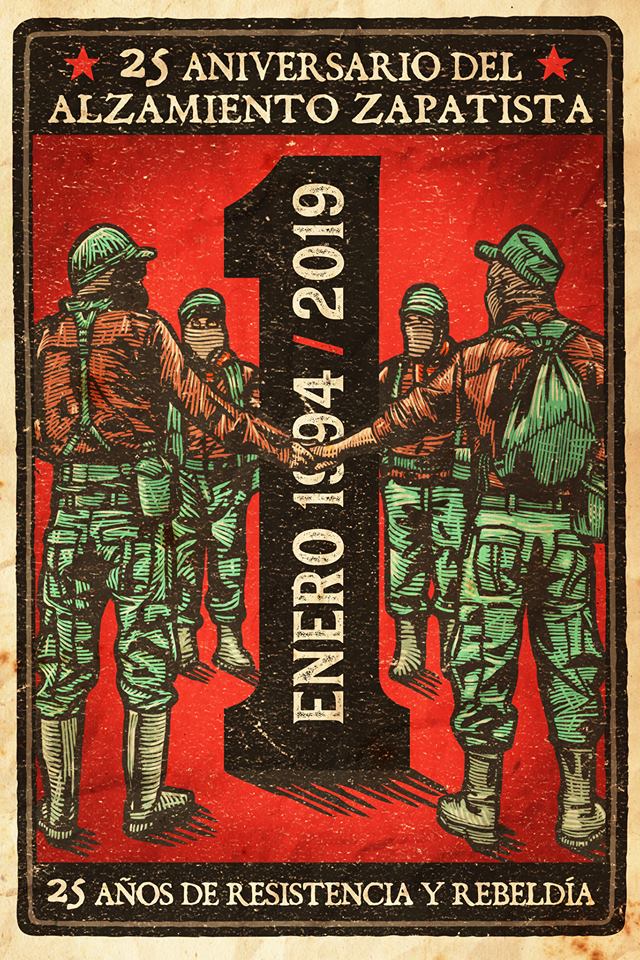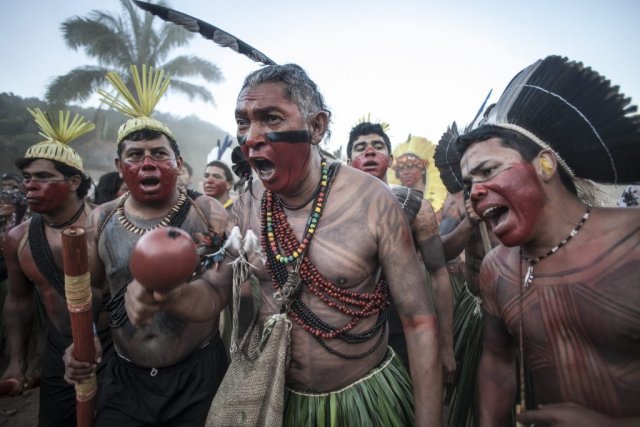Since 1992, the “500 Years of Indigenous, Black and Popular Resistance” Campaign and the Rio Earth Summit, Indigenous Peoples are more and more represented in the different Social Forums, the counter summits and the international meetings. They bring their own worldview and another way of seeing it and perceiving it. Several movements, like the Zapatistas one in Mexico influence the alter-globalization and “those who have the heart in the bottom left”, as they say. Their unique relationships to the land, their territories, and the environment, are some assets in order to create a new society, full of social and climate justice. It is time to listen to them and support them in the defense of their rights in a decolonial perspective and in the building of another future. These are the reflections, goals and reclaims, that the working group “Rights of Indigenous Peoples” by Intercoll, wants to highlight, put in on common and support.
“Indigenous Peoples”? A lexical and political issue
The word “Indigenous” appeared for the first time in the late 1970s, thanks to peoples who were considered at that time as “minorities” in the USA and Canada. In nearly 15 years, this vocabulary have resonated with Indigenous Peoples, still called “populations,” who have claimed it at an international level. According to the UNESCO, Indigenous peoples represented from 370 to 500 millions of peoples through the world, in 22% of the planet.
The raise of this movement – first leaded by Native American only – with some powerful claims about their recognization, their respect and their rights, on their ancestral lands, is part of several events that happened in the USA in order to obtain the civic and social rights for African-Americans peoples, supported in particular by the Black Panthers Movement. 1974 was a very important year, while took place in the Sioux Lakota Standing Rock Reservation (North Dakota, USA) the gathering known as the “Sovereign Indigenous Nations” meeting. This was the first contribution to the recognization of Indigenous Peoples. Several thousands of Native American delegates gathered and made an agreement creating the “International Indian Treaty Council”. In order to pursue this internationalist perspective, the promoters of this first meeting reaffirm their action by organizing the next year, in 1975, a second gathering, this time in Port-Alberny (Canada). Over 50 Indigenous leaders came together, coming from the Americas, Europe (Sami People), and Pacific area (Maori People and Aboriginal peoples from Australia). This was the creation of the World Council of Indigenous Peoples. Created in 1968, the International Work Group for Indigenous Affairs (IWGIA) took also an important place in these dynamics. The issue of Indigenous peoples recognization and their rights needed to make another step: to access the United Nations Organization (UN). The mobilization of the NGO called IWGIA in this process was very important to the Indigenous organizations, and permitted that the major conference about “The discrimination against Indigenous Populations of the Americas” took place in 1977 (Morin, 2006: 11-12). The long protest against the use of the term “populations” could celebrate an important victory as 40 years after, the United Nations Declaration about Indigenous Peoples Rights was adopted in 2007.
Land rights vs. Extractivism
Despite the role and the place that Indigenous peoples have in the international structures and the international forums, their rights need to be reaffirm every day. The reference to the « Sovereign Indigenous Nations » gathering in Standing Rock is not insignificant. Indeed, in this Sioux Lakota Reservation took place one of the most important indigenous protests since that time. From April 2016 to February 2017, more than 200 Indigenous nations, coming from the USA, Canada, Mexico, and international supports from Palestine and Europe, gathered in order to fight all together against a pipeline project known as the Dakota Access Pipeline (DAPL), that Energy Transfer Partners was in charged of and that the American government supported. The election of Donald Trump ended the protest, as one of the first decrees took by President Trump was to achieve the building of the pipeline. However, the struggle against DAPL was not a defeat. This event permits to see several Indigenous peoples of the Americas and from all over the world fighting some extractivist projects, that threaten the preservation of their lands, their traditions and their ways of life. In addition, these movements against different pipelines permitted to emphasize the idea that the protection of Mother-Earth is not an Indigenous issue but concerns each and everyone of us. To a certain extent, this reminds us some international ecologist movements. Other protests are still occurring, like the struggle against the Line 3 pipeline by Enbridge in the Great Lakes area (USA), or the fight leaded by the Secwepemc peoples against the extension of the Trans Mountain pipeline by Kinder Morgan (British-Columbia, Canada). Finally, a major fight is occurring in the same area, this time leaded by the Unist’o’ten camp, member of the Wet’suwet’en Nation, that is also fighting against the pipeline on their lands, against the Canadian tactical and police forces that evacuated several protesters a couple of months ago. At the same time happened a pipeline explosion in Mexico, killing 73 persons and injuring more than 70 other ones. The struggle against extractivism is not the only one that Indigenous peoples are leading. In Chile and Argentina, the Mapuche fight to get back their right to the land and against firms like Benetton, that steal their ancestral land in the only perspective to do some profit and nurture the capitalistic system.
These types of resistance are some examples of how different movements converge, and reclaim at the same time the protection of Indigenous Peoples lands, a new world where the respect of nature and environment would be a priority, but also permit to see how some forms of resistance are created through the alliance of the fight against extractivism, capitalism and imperialism. In other words, the movements leaded by Indigenous Peoples wonder who is behind all of these murdered projects. Here it is: the three-headed hydra that is capitalism, whom power is still in the hands of governments, multinational firms and banks.
France is not unrelated to this situation. Five banks have fund the building of the DAPL pipeline (Société Générale, BNP Paribas, Credit Agricole), Vinci – through its subsidiary The Spiecapag – is hiding behind the expansion of the Trans Mountain pipeline. Finally, and it is important to reaffirm it, France continues to exploit and loot its own colonies, like the so-called French Guiana, through the mega-project Montagne d’Or, supported since recently by the French President Emmanuel Macron. This project threatens the existence and survival of 6 Indigenous Peoples: Kali’na, Teko, Paykweneh, Wayana, Wayapi and Lokono (Arawaka). France continues to reaffirm its imperialism above other continents, like Oceania. In 2018 took place in New-Caledonia (Kanaky) the referendum for the independence, wished by the majority of the Kanak people who want to reaffirm its sovereignty and self-determination, while New-Caledonia is still on the UN list of the countries that have to be decolonized…
Colonized lands, murdered bodies: from the lands exploitation to the Indigenous women feminicides
Facing the extractivist projects, Indigenous women are on the front line. Nevertheless, the fact that they are women and Indigenous put them twice in danger. Indeed, between 1980 and 2012, over 1181 Indigenous women have been killed or vanished in Canada. The construction sites that start across the Americas in order to exploit the lands and loot its natural resources involve the creation of buildings for the workers, that increases the risks incurred by Indigenous women to be raped or forced to participate in people trafficking. This is what some groups of Indigenous women are fighting in Brazil, Mexico or Canada, through the struggle against the “men camps”, consequence of the extension of the Trans Mountain pipeline. By analogy, to reaffirm and apply effectively of Indigenous lands rights also imply to reaffirm peoples’ and women’s right to life.
Towards a decolonization of langages and minds…
While 2019 has been declared International Year of Indigenous Languages by the UNESCO, the recognization and effective application of Indigenous Peoples rights also concern the conservation of their cultures and traditions. Preserving and teaching original languages of these peoples are some fundamental sovereignty and decolonial issues. Some interesting initiatives are emerging, also thanks to digital technology. Some apps are developed in order to preserve, maintain and promote Indigenous languages, while the number of speakers have constantly decreased because of the forced learning of English, French, Spanish, and Portuguese languages, everywhere Indigenous peoples have been dominated by colonial empires.
The recognization and valorization of Indigenous languages are seen in the increasing use of some concepts created to rethink this world and build some new ones, especially in social movements, international forums and scientific researches. We can think to the notion of buen vivir that, even if it is a Spanish one, finds its roots into differents Indigenous languages of South America: sumak kawsay in Quechua, suma kamaña in Aymará, ñande reko in Guarani, shiir waras in Ashuar, küme mongen (Thompson, 2017 : 2) in Mapudungun, Mapuche people language.
Each of these terms come from different cosmologies reflected by these languages. Other concepts also permit to emphasize the Indigenous believes and spiritualities that imply other ideas that the colonial languages do not permit to translate. It is also the case concerning the word hozho in Diné language, a difficult notion that implies a healthy life, in harmony and beauty. These kinds of examples are numerous, as we can also mention the notion of mauli ola (coming from Kanaka Maoli, Indigenous People from Hawaii), or also the notion of ubuntu in luba (Democratic Republic of Congo). Through these concepts, the goal is especially to reaffirm the relations that exist between the human beings, and more generally, all living beings, to their land and environment. This is what the notion of pachamama refers to, coming from the aymara cosmology in Bolivia, that has some points in common with the “Mother Earth” one that is used and reclaimed by many movements of resistance across the planet. This is a way to legitimize its protection for the next generations, by all of us. This year is a crucial moment in the reaffirmation of the rights, cultures and languages of these peoples, who permit to rethink and build a new future.





